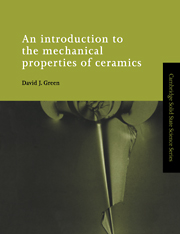Book contents
- Frontmatter
- Contents
- Preface
- Chapter 1 Introduction
- Chapter 2 Elastic behavior
- Chapter 3 Effect of structure on elastic behavior
- Chapter 4 Elastic stress distributions
- Chapter 5 Viscosity and viscoelasticity
- Chapter 6 Plastic deformation
- Chapter 7 Creep deformation
- Chapter 8 Brittle fracture
- Chapter 9 Strength and engineering design
- Comprehension exercises
- Appendices
- Index
Chapter 4 - Elastic stress distributions
Published online by Cambridge University Press: 02 February 2010
- Frontmatter
- Contents
- Preface
- Chapter 1 Introduction
- Chapter 2 Elastic behavior
- Chapter 3 Effect of structure on elastic behavior
- Chapter 4 Elastic stress distributions
- Chapter 5 Viscosity and viscoelasticity
- Chapter 6 Plastic deformation
- Chapter 7 Creep deformation
- Chapter 8 Brittle fracture
- Chapter 9 Strength and engineering design
- Comprehension exercises
- Appendices
- Index
Summary
It is important to be able to solve elasticity problems for a variety of different loading geometries. The equations of elasticity do not possess unique solutions unless residual stresses are ignored but fortunately the principle of superposition allows one to deal with these as a separate issue. This principle can also be used to build up solutions of complicated problems by superposing a set of simpler problems. In this chapter, some simple elastic stress distributions for linearly elastic isotropic bodies will be shown and discussed. In these solutions there will be simplifying features that allows the general equations of elasticity to be bypassed.
An immediate difficulty in studying loaded bodies is that external forces are often applied to the body in complicated ways, e.g., through bolts, pins, collars, etc. This means that stresses can be complex in the loading region; they may vary sharply, especially if there are changes in the contours of the body. Fortunately, these stresses are generally localized to the region of contact and will not change the stress and strain distribution away from the contact region. This effect is expressed by St Venant's Principle, ‘If the forces acting on a small part of a body are replaced by a statically equivalent set of forces (i.e., with the same resultant force and couple) acting on the same area, the stress state will be changed negligibly at large distances compared to this area.’
- Type
- Chapter
- Information
- An Introduction to the Mechanical Properties of Ceramics , pp. 105 - 133Publisher: Cambridge University PressPrint publication year: 1998

